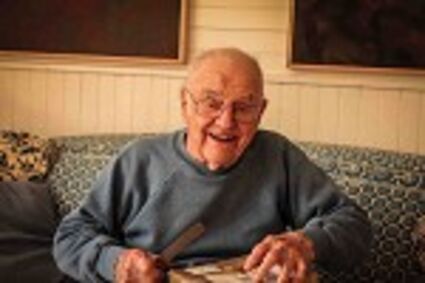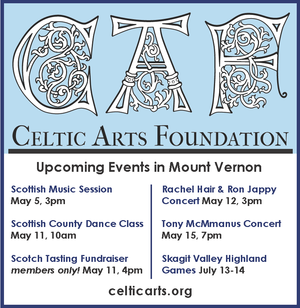CLAYTON BERNARD JAMES
October 5, 2016

(Photo by Andy Szurek)
Clayton Bernard James, of La Conner, noted painter and sculptor and an important figure in Northwest art history, died on Sunday, October 2 in Burlington, at the age of 98.
Clayton was born on Feb. 6, 1918 in Belding, Eureka Township, Michigan to Albert Edward James and Anna Neva Sturgeon James. His siblings Laurence, Walter and Frances preceded him in death.
He attended Rhode Island School of Design, where he met painter Barbara Straker James. They married in 1944. She preceded him in death in 2007 after 63 years of marriage.
A conscientious objector during World War II, Clayton spent several years in work camps on both coasts, including Camp Angel in Waldport, Oregon. The camp included a number of artists, writers and performers with whom Clayton and Barbara were to maintain friendships throughout their life together.
Clayton and Barbara were introduced to the Skagit Valley by artist Morris Graves and settled permanently in La Conner in 1953.
They were drawn, in large part, by their friendship with painter Guy Anderson. The influence of Graves — and the presence in La Conner of Anderson, Clayton James and Barbara Straker James — served to establish the Skagit Valley as a center of the burgeoning “Northwest School” of art.
It was in La Conner in the early 1950s that James began to turn from painting to three-dimensional sculpture, including wood carving, cast cement and the large-scale coiled clay vessels for which he would later be known.
Clayton and Barbara spent a winter in New Mexico in 1976-77, and the experience was pivotal. He was exposed to the powerful, austere forms of ancient Native American vessels and returned to La Conner to begin the creation of what would soon be the most powerful work of his career. His large, hand-built vessels were meticulously built — and fired in an outdoor kiln at his studio that he built himself — yet with organic surfaces of subtle variation.
In the 1980s, Clayton turned from vessel shapes to a variety of three-dimensional clay sculpture, many of which were cast in bronze.
In the early 1990s, Clayton returned to his original medium of oil painting and headed outside for what was to become more than two decades of exemplary plein air painting. Often accompanied by his artist friends Dederick Ward, Ed Kamuda and the late Paul Havas, Clayton tackled the landscapes of Washington: the peaks of the North Cascades, the ancient lakes and basalt geology of the coulee region and the rivers, fields and forests of the Skagit Valley near his home in La Conner.
Clayton James’ work has been exhibited and collected widely throughout the Northwest and beyond. It was the subject of a retrospective exhibition at the Museum of Northwest Art in 2002.
Except for a short period of hospitalization and nursing care at the end of his life, Clayton was able to achieve his wish to remain in his own home and studio, thanks to the devoted care and support he received from a wide circle of friends, artists and community members the last almost six years of his life.
Clayton continued to go to his studio well into his 90s until health issues limited his painting. However, he remained an active member of the Skagit Valley art community and treasured his conversations with fellow artists about their work, new exhibitions and books. An avid and thoughtful gardener, he remained interested in his garden until the end of his life, accompanied on garden inspections by his beloved cat, Morris.
A memorial gathering to honor Clayton James will be scheduled soon.












Reader Comments(0)